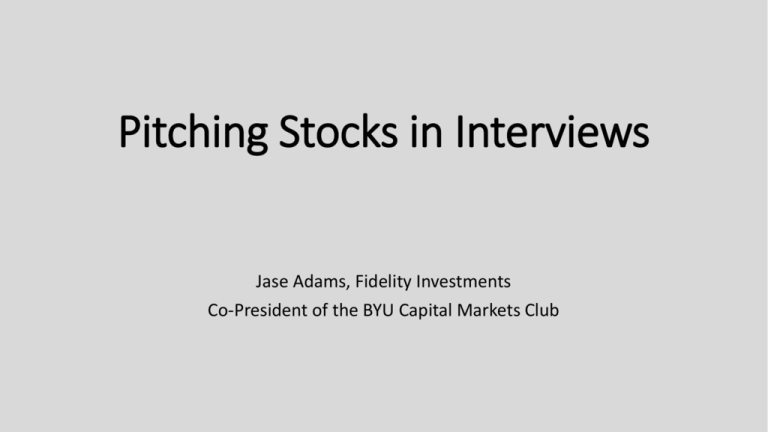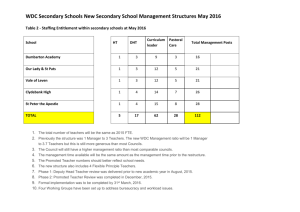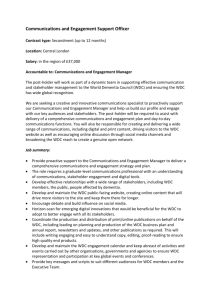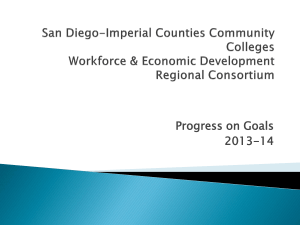Stock Pitching - BYU Finance Society
advertisement

Pitching Stocks in Interviews Jase Adams, Fidelity Investments Co-President of the BYU Capital Markets Club Picking a Company • Large Cap vs. Small Cap • • • • Small Cap is by far a better choice because it gives you an edge There are greater market inefficacies The interviewer will be less likely to have heard of the company The companies are usually easier to understand and explain • Put your money where your mouth is • If you find a company that you really like – go open a brokerage account • Pitch a company that you already own in your personal portfolio Where to Get Information • SEC Filings • Company website • Company presentations • Earnings transcripts • Sell-side reports • Investment Blogs • Morningstar • Bloomberg • Yahoo Finance Get an Edge – Do Proprietary Research • Call the management team • Speak to the company’s investor relations team • Conduct surveys • Visit stores or factories • Talk to competitors • Buy their products • Use their services • Ask your friends and family What Makes a BUY, SELL, or HOLD? • The market, on average, returns 10% a year • 5-15% upside should therefore be a “Hold” • Anything with more than 15% upside is a “Buy” • Less than 5% upside should be a “Sell” • Equity research is more of an art than it is a science • There is a lot of room for judgment and discretion • Ultimately the market will price each and every stock • Go big or go home • Leave an impression with big potential upside on your pitches • Only time will tell if you are right or wrong with your analysis Writing a Good Thesis • Start with an industry view • Exposure to positive or negative macroeconomic trends or themes • 2-3 fundamental based catalysts • Focus on how you differ from consensus view, give numbers • Almost all stories trade on revenues, margins, and cash flows • End with valuation • Should be multiple based, include ranking, and upside/downside in percent • Everything should be forward looking and contrasted to consensus Thesis Example #1 – Skullcandy (SKUL) • Despite rapid growth, increasing competition has led to the commoditization of smartphone accessories and audio hardware. • Due to market saturation, Skullcandy’s revenue growth is decelerating faster than investors currently expect. I see 2014 revenues of 205 million vs. consensus of 233 million. • Margins continue to erode and forward EPS revisions have not bottomed. My 2014 EPS estimate of $0.10 is 50% below the street. • The company is worth $3.50 based on a multiple of .5x 2014 sales making it a SELL with 40% downside. Thesis Example #2 – Vitamin Shoppe (VSI) • Aging demographics and health awareness are favorably driving sports nutrition, wellness products, and specialty supplements. • Because VSI prices its products on average 10% cheaper than its competitors, I am more optimistic than the market on same store sales growth (I’m at 3-4% vs. 2% on Wall Street for 2014). • Operating margins should increase 250 bps to 13% over the next couple years as online sales account for a larger share of total revenue generation. Current price implies stable margins. • The stock is worth $50 based on 18x my 2014 EPS of $3.80 for 20% upside making it a BUY. Best Practice: Two Minute Pitch • Start with valuation and the upside/downside to grab their attention • Run through each of the points of your thesis • End with valuation and action (BUY or SELL) • http://www.youtube.com/watch?feature=player_detailpage&v=czAo H3vonec Best Practice: One Page Summary Things to consider on your one page summary (You don’t need all of them) • Investment thesis • Brief company description • Recent news • Upcoming catalysts • Investment risks • Industry view • Bull case vs. bear case • Valuation and price target A Couple of Real Examples (WDC and QCOR) • I pitched QCOR and WDC in my Fidelity interviews • The slides below were taken from my one page write up • These were pitched in February, 2013 Western Digital Corporation (WDC) Overview • WDC is one of the worlds largest hard disk drive manufacturers. • Have about 45% market share with one real competitor - Seagate. • With recent market consolidation, prices have been effectively raised. • Even with PC demand in decline, volume shipments have only slightly contracted. • The company sees 33% CAGR for data storage the next 10 years. Western Digital Corporation (WDC) HGST Acquisition • Hitachi Global Storage Technologies was acquired in March 2012. • At the time it had almost $6b in revenues • Operates a solid state drive product line and also an enterprise segment. • It now operates as a separate brand as a subsidiary of WDC. Western Digital Corporation (WDC) Threat of New Technologies • Solid state drives are more energy efficient and slightly faster. • This is the general trend in the industry. • Most tablets and portable computing devices use SSD. • HDD are still a tenth of the cost of SSD on a gigabyte/dollar basis. • Emerging markets are still investing in infrastructure that use HDD. • WDC has pioneered in hybrid storage and is transitioning to new technologies. • HDD will not be obsolete as fast as the market predicts. Western Digital Corporation (WDC) Valuation Summary The firm has returned a significant amount of capital to its shareholders. It has the potential to generate $4b a year in operating cash flows and $3b a year in free cash flows. It is trading incredibly cheap with a trailing PE multiple around five. The current stock price is around $46. I value the firm by discounting free cash flows for the next five years (present value of $10b) and adding the net asset value of the firm ($9b as of the latest quarter) to get an intrinsic stock price of $80. This is conservative based on the fact that I have opted out of using a terminal value after 5 years of cash flows. Assuming WDC is able to establish any sort of foothold in the SSD market, the company will be worth much more. Questcor Pharmaceuticals (QCOR) Main Story • One drug, Acthar Gel, which treats about five major diseases. • $500m in revenue with an addressable market of at least $6b. • The manufacturing process is a trade secret. • Its a biologic drug which means that genetic drugs don’t have the same effect. • The drug is used once a year and costs $23,000. • Pricing is not an issue because the patients do not have to pay for it. • No major pharmaceutical wanted the drug due to the difficult manufacturing process. • The company works closely with Doctors to market the drug and bring awareness. Questcor Pharmaceuticals (QCOR) Multiple Sclerosis • MS is normally treated with steroids, Acthar Gel is a last resort drug. • Cheaper than many maintenance MS drugs. • Doesn’t have the negative side effects that steroids have. • 30-100k MS patients do not respond to steroids for flare-ups. • $30k per script means a $3b total addressable market. • Almost 10k cumulitive scripts written equating to about 15-30% penetrated. Questcor Pharmaceuticals (QCOR) Nemphrotic Syndrome and Other Indications • About 25k patients with membranous nephropathy. • $200-250k per script means there is a $5b total addressable market. • They have written 1,500 cumulative scripts, so there is still a huge market. • Also treats infantile spasms and rheumatology. • Currently in phase two for indication for diabetic nephrology. • There is currently no drug to treat this disease. Questcor Pharmaceuticals (QCOR) Short Interest and Other Risks • The shorts’ main thesis is that it is a one drug company, so there are higher risks. • The DOJ has investigated some of its business practices. • Insurance companies are not happy about the pricing of the drug. • Currently a “Tier 3” drug with the rest of the ultra expensive drugs. Questcor Pharmaceuticals (QCOR) Valuation Thesis The company should be trading at much higher multiples because of its high growth history and potential. Since the shorts have gotten involved, the stock has cut in half. The DOJ will likely not find anything wrong with QCOR’s business practices and will at most impose a one time fine to the company. The company is currently trading at $26. I value the company at around $50 based on an EV to EBITDA ratio of 9 times 2013 estimates.








